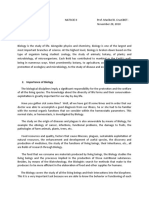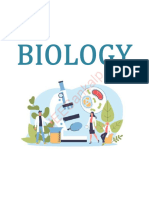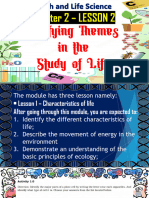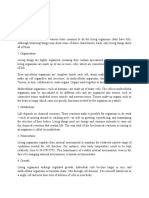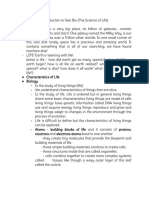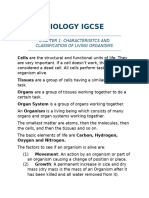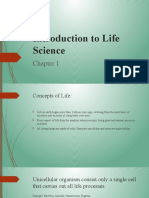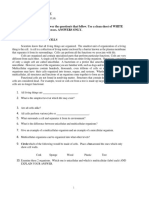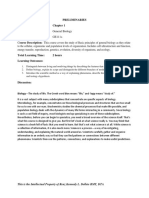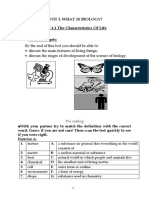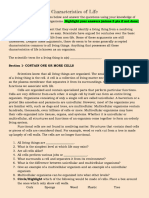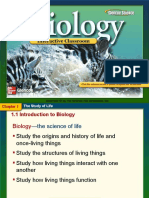7 Characteristic Features of Life
7 Characteristic Features of Life
Uploaded by
marjureeq4298Copyright:
Available Formats
7 Characteristic Features of Life
7 Characteristic Features of Life
Uploaded by
marjureeq4298Copyright
Available Formats
Share this document
Did you find this document useful?
Is this content inappropriate?
Copyright:
Available Formats
7 Characteristic Features of Life
7 Characteristic Features of Life
Uploaded by
marjureeq4298Copyright:
Available Formats
7 Characteristic Features of Life If you study biology, characteristics that define life is one of the foremost things that
you will learn. All living organisms exhibit these features. They share these basic properties of life, which categorizes them as living and therefore different from inanimate beings. While there are some characteristics that are species specific, these seven life characteristics are common to all living beings. Here we take a look at what are the characteristic features of life. Cells Cells are the basic units of life of every living organism. All living beings are composed of one or more cells. There are unicellular organisms that are made up of just one cell and multicellular organisms that are made up of many cells with each cell having specific functions. A cell consists of organelles like mitochondria, nucleus, Golgi apparatus, etc. which are the equivalents of organs in our body. These organelles are made up of carbohydrates, proteins, lipids, and nucleic acids and perform functions like producing energy in the form of ATP, transferring molecules, synthesis of proteins, etc. Cells that are of the same type combine and form tissues which in turn form organs. Homeostasis All living organisms maintain homeostasis, which is the process by which the internal environment of the body is regulated in order to maintain a stable state. This process was defined first by Claude Bernard and then by Walter Cannon. All organisms need to maintain a stable environment in order to sustain cell metabolism that is essential to life. If the internal environment of an organism is disturbed, then it is possible that the normal processes are disrupted. One of the best examples to explain this phenomenon of maintaining homeostasis is how the body balances change in body temperature by performing actions that balance out. If you are feeling cold, then inadvertently you tend to shiver which, causes the muscles to produce heat. Alternatively, if you are feeling hot, then the body produces sweat that helps in evaporation of heat from the body. Heredity All living organisms receive some hereditary traits from their parent organisms. All organisms pass their genes to their off-springs. Genes which are composed of DNA have all the information that are hereditary in nature. These genes are what make an organism predisposed to exhibit certain characteristics or to behave in a certain manner. The study of heredity is called genetics and it is heredity that causes a species to evolve by accumulation of different characteristics from parent organisms over a period of time. This is one of the most important characteristics of life. Use of Energy All living organisms need energy to perform various functions like development, growth, damage repair, reproduction, etc. Most living organisms need this energy in the form of ATP and their requirement stems from the need for energy for the functions of movement and metabolism. Metabolic activities involve a set of processes that allow living organisms to maintain life. Anabolism uses energy to convert chemicals into cellular components like molecules and catabolism produces energy by breaking down molecules from organic matter. Plants convert the energy derived from sunlight to produce nutrients by the process of photosynthesis. Animals on the other hand consume other organisms to supplement their need for energy. Reproduction All living organisms reproduce, which is the process by which new organisms of the same type are produced. Reproduction can be asexual, where a single parent produces an organism or sexual, which combines male and female sex cells and two parent organisms of each gender contribute hereditary information to the organism. When a unicellular organism divides to form a daughter cell, it is called asexual reproduction and the process by which animals reproduce is called sexual reproduction. Response to Environment All living organisms respond to stimuli in their environment, like light, temperature, sound, heat, etc. The response can be in any form, for example when unicellular organisms are exposed to chemicals, they contract. In human beings, an accidental touch with any object exhibiting extreme temperatures can cause a sudden jerk. Response is generally expressed by an organism by some kind of motion. Evolution and Adaptation All organisms undergo the process of adaptation to suit themselves to their environment. For example, most plants that are found in the desert have succulent leaves that allow them to store and conserve water. They evolve over a period of time according to their environment. This is fundamental to the process of evolution. If you need to explain this biological concept to students, then the best way to do the same would be to use different living organisms and make a characteristics of life worksheet, that will allow the students to study these functions in a more practical manner. Hopefully, this article on the different characteristics of living things has helped you understand the primary difference between a living organism and an inanimate object.
You might also like
- What Is Biology?Document5 pagesWhat Is Biology?VidGe MasaquelNo ratings yet
- Cells and Organization: What Is Life?: The Seven Characteristics of LifeDocument9 pagesCells and Organization: What Is Life?: The Seven Characteristics of LifeClarisse MendozaNo ratings yet
- Introduction To BiologyDocument6 pagesIntroduction To BiologyPamela MorcillaNo ratings yet
- General ZoologyDocument2 pagesGeneral ZoologyJohnren Godinez BoocNo ratings yet
- Characteristics of Living ThingsDocument11 pagesCharacteristics of Living ThingsJohn Osborne100% (1)
- Properties of Life: Biology Is The Science That Studies Life. What Exactly Is Life? This May Sound Like A SillyDocument27 pagesProperties of Life: Biology Is The Science That Studies Life. What Exactly Is Life? This May Sound Like A SillySandra Nicole RiveraNo ratings yet
- General BiologyDocument4 pagesGeneral BiologyKasai KristineNo ratings yet
- Chapter 10 Classification of Living and Non-Living ThingsDocument11 pagesChapter 10 Classification of Living and Non-Living ThingsJulius MacaballugNo ratings yet
- Biology - Living WorldDocument21 pagesBiology - Living Worldpushpenderchoudhary160No ratings yet
- Define BiologyDocument11 pagesDefine BiologyPatricia PaezNo ratings yet
- Unifying Themes in The Study of Life ScienceDocument41 pagesUnifying Themes in The Study of Life ScienceKath Tan Alcantara100% (1)
- GROUP 2 Unifying ThemeDocument18 pagesGROUP 2 Unifying ThemeKim NapataNo ratings yet
- Chapter - 1 The Living World - WatermarkDocument23 pagesChapter - 1 The Living World - WatermarkMehak ShireenNo ratings yet
- General BiologyDocument14 pagesGeneral BiologyLara Loraine Norbe VicenteNo ratings yet
- 2nd Lecture Generan Biology PartDocument5 pages2nd Lecture Generan Biology Partyr44grf94kNo ratings yet
- Characteristics of LifeDocument5 pagesCharacteristics of LifeVan Denver Evangelista BautistaNo ratings yet
- Characteristics of LifeDocument5 pagesCharacteristics of LifeVan Denver E. BautistaNo ratings yet
- Campbell Biology - Chapters 1 Ans 2 SummaryDocument17 pagesCampbell Biology - Chapters 1 Ans 2 SummaryYana JohansonNo ratings yet
- Lesson 2-Quarter 2Document30 pagesLesson 2-Quarter 2MJ DEL AGUANo ratings yet
- q2 Earth and Life Science Lesson 2Document33 pagesq2 Earth and Life Science Lesson 2jeyzellaidanNo ratings yet
- ScienceDocument22 pagesSciencesaisabaareeshNo ratings yet
- Properties of LifeDocument4 pagesProperties of LifeAndy Bautista De LeonNo ratings yet
- Eals 1Document6 pagesEals 1Anne CabrerosNo ratings yet
- Lecture 1 BIO101Document9 pagesLecture 1 BIO101Ahamadul Islam OnonnoNo ratings yet
- Biology: The Science of LifeDocument63 pagesBiology: The Science of LifeCrisse Diane OngsingcoNo ratings yet
- Basic NeedsDocument3 pagesBasic Needssyedputra_teenNo ratings yet
- Characteristics of Living ThingsDocument18 pagesCharacteristics of Living Thingsjprecious969No ratings yet
- Diversity in The Living WorldDocument17 pagesDiversity in The Living WorldRiya Singh100% (1)
- Lecture Notes in Biological ScienceDocument96 pagesLecture Notes in Biological Sciencemicx ramos100% (2)
- Concepts of Biology Chapter 1Document40 pagesConcepts of Biology Chapter 1hazharomar958No ratings yet
- The Characteristics of Living ThingsDocument8 pagesThe Characteristics of Living ThingsMiy El NinoNo ratings yet
- Living ThingsDocument14 pagesLiving Thingscourse heroNo ratings yet
- Introduction To Gen BioDocument6 pagesIntroduction To Gen BioPearl Madeleine FranciscoNo ratings yet
- Lesson 1Document5 pagesLesson 1api-308572747No ratings yet
- Chapter 1 - Characteristics and Classification of Living Organisms (Notes) (BIOLOGY IGCSE)Document14 pagesChapter 1 - Characteristics and Classification of Living Organisms (Notes) (BIOLOGY IGCSE)notblacknigNo ratings yet
- Attributes of LifeDocument3 pagesAttributes of LifeZoeNo ratings yet
- Unit I. What Is Biology?: Text 1.1 The Characteristics of LifeDocument15 pagesUnit I. What Is Biology?: Text 1.1 The Characteristics of LifeNur InayahNo ratings yet
- LIFE SCIENCE - Lesson 1 NotesDocument2 pagesLIFE SCIENCE - Lesson 1 NotesRivaille JaegerNo ratings yet
- Text 1.1 The Characteristics of LifeDocument7 pagesText 1.1 The Characteristics of LifeArina Ulin NiamaNo ratings yet
- Introduction To Life ScienceDocument19 pagesIntroduction To Life ScienceMarchee AlolodNo ratings yet
- What Is LifeDocument3 pagesWhat Is Lifejones.tierra.97No ratings yet
- Lecture BZE Life-HomeostasisDocument10 pagesLecture BZE Life-Homeostasiscarolinebrongelcopti24No ratings yet
- Activity No. 2 Characteristics of LifeDocument5 pagesActivity No. 2 Characteristics of Lifecherrylynmoso10No ratings yet
- Module 1 Introduction To Biology (GE111)Document8 pagesModule 1 Introduction To Biology (GE111)Nathaniel Victor BalerNo ratings yet
- Unifying Themes in The Study of LifeDocument7 pagesUnifying Themes in The Study of LifeKyla Renz de Leon100% (6)
- BIO101 Updated Highlights by HaalimDocument104 pagesBIO101 Updated Highlights by HaalimAtif MubasharNo ratings yet
- THE-NATURE-OF-LIFE ScienceDocument37 pagesTHE-NATURE-OF-LIFE Sciencekylamae JinonNo ratings yet
- Biology Bacterium Yeast: Cell, inDocument11 pagesBiology Bacterium Yeast: Cell, inAlelli Bianca Daniel AlipioNo ratings yet
- Unit 1 What Is BiologyDocument23 pagesUnit 1 What Is BiologySela Siti DeliantiNo ratings yet
- Human Biology 1Document14 pagesHuman Biology 1Arwa AhmedNo ratings yet
- Characteristics of Life: Watch The Video, Read Through The Powerpoint, and Answer The Questions at The EndDocument10 pagesCharacteristics of Life: Watch The Video, Read Through The Powerpoint, and Answer The Questions at The EndAngielaNo ratings yet
- Public Health and SafetyDocument11 pagesPublic Health and SafetyEric AryeepahNo ratings yet
- Biology, The Scientific Method & The Metric SystemDocument10 pagesBiology, The Scientific Method & The Metric Systemrakhmatov UlanNo ratings yet
- 1 Introduction To Biology: 1.1 Themes and Concepts of BiologyDocument20 pages1 Introduction To Biology: 1.1 Themes and Concepts of BiologysivaNo ratings yet
- BiologyDocument86 pagesBiologyhoxojew752No ratings yet
- Introduction To BiologyDocument33 pagesIntroduction To BiologyAghoweh Clintin TonifarNo ratings yet
- Characteristics of Life - HWDocument6 pagesCharacteristics of Life - HWlaquisha.smithNo ratings yet
- Module 1 - Introduction To BiologyDocument7 pagesModule 1 - Introduction To BiologyYsabela Dela PazNo ratings yet
- Biology IntroductionDocument26 pagesBiology IntroductionCabdirisaq CaraleNo ratings yet

